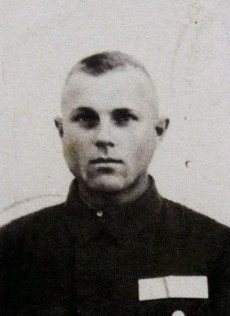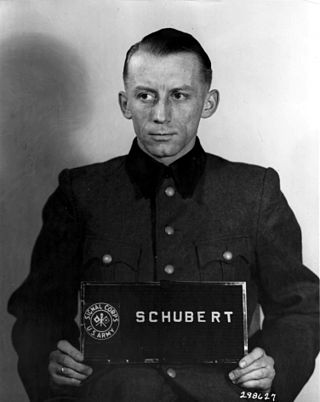
Der Stürmer was a weekly German tabloid-format newspaper published from 1923 to the end of World War II by Julius Streicher, the Gauleiter of Franconia, with brief suspensions in publication due to legal difficulties. It was a significant part of Nazi propaganda, and was virulently anti-Semitic. The paper was not an official publication of the Nazi Party, but was published privately by Streicher. For this reason, the paper did not display the Nazi Party swastika in its logo.

Aktion T4 was a campaign of mass murder by involuntary euthanasia which targeted people with disabilities in Nazi Germany. The term was first used in post-war trials against doctors who had been involved in the killings. The name T4 is an abbreviation of Tiergartenstraße 4, a street address of the Chancellery department set up in early 1940, in the Berlin borough of Tiergarten, which recruited and paid personnel associated with Aktion T4. Certain German physicians were authorised to select patients "deemed incurably sick, after most critical medical examination" and then administer to them a "mercy death". In October 1939, Adolf Hitler signed a "euthanasia note", backdated to 1 September 1939, which authorised his physician Karl Brandt and Reichsleiter Philipp Bouhler to begin the killing.

John Demjanjuk was a Trawniki man and Nazi camp guard at Sobibor extermination camp, Majdanek, and Flossenbürg. Demjanjuk became the center of global media attention in the 1980s, when he was tried and convicted in Israel after being identified as "Ivan the Terrible", a notoriously cruel watchman at Treblinka extermination camp. In 1993 the verdict was overturned. Shortly before his death, he was tried and convicted in the Federal Republic of Germany as an accessory to the 28,060 murders that occurred during his service at Sobibor.

Hans Josef Maria Globke was a German administrative lawyer, who worked in the Prussian and Reich Ministry of the Interior in the Reich, during the Weimar Republic and the time of National Socialism. Later he was the Under-Secretary of State and Chief of Staff of the German Chancellery in West Germany from 28 October 1953 to 15 October 1963 under Chancellor Konrad Adenauer. He is the most prominent example of the continuity of the administrative elites between Nazi Germany and the early West Germany.

Josef Bühler was a German lawyer who, as the protégé of Governor General Hans Frank, rose to become his deputy as the State Secretary in the Nazi Germany-controlled General Government in Kraków during the Second World War. He participated in the January 1942 Wannsee Conference, at which the genocidal Final Solution to the Jewish Question was planned. He was convicted of crimes against peace, war crimes and crimes against humanity, and was executed.

Kurt Max Franz Daluege was a German SS-Oberst-Gruppenführer and Generaloberst of the police, the highest ranking police officer, who served as chief of Ordnungspolizei of Nazi Germany from 1936 to 1943, as well as the Deputy/Acting Protector of Bohemia and Moravia from 1942 to 1943.

Georg Konrad Morgen was an SS judge and lawyer who investigated crimes committed in Nazi concentration camps. He rose to the rank of SS-Sturmbannführer (major). After the war, Morgen served as witness at several anti-Nazi trials and continued his legal career in Frankfurt.
Michel Thomas was a polyglot linguist, and decorated war veteran. He survived imprisonment in several Nazi concentration camps after serving in the Maquis of the French Resistance and worked with the U.S. Army Counter Intelligence Corps during World War II. After the war, Thomas emigrated to the United States, where he developed a language-teaching system known as the "Michel Thomas method". In 2004 he was awarded the Silver Star by the U.S. Army.
Major William D. Browne is a former U.S. Army officer. He served in the postwar occupation military government of Germany, as a Major in the Third Army. He was involved in the recovery of German documents at the end of World War II.

The Korherr Report is a 16-page document on the progress of the Holocaust in German-controlled Europe. It was delivered to Heinrich Himmler on March 23, 1943, by the chief inspector of the statistical bureau of the SS and professional statistician Dr Richard Korherr under the title die Endlösung der Judenfrage, in English the Final Solution to the Jewish Question. Commissioned by Himmler, Korherr calculated that, from 1937 to December 1942, the number of Jews in Europe had fallen by 4 million. Between October 1939 and December 31, 1942, 1,274,166 Jews had been "processed" at the camps of the General Government and 145,301 at the camps in Warthegau.

Robert Wolfe was a World War II U.S. Army officer, historian, and retired senior archivist of the US National Archives. He was wounded in both the Pacific and European Theaters of Operation. He commanded a recon team and also an anti-landmine platoon. He was a subject-matter expert on captured Nazi war documents. Wolfe worked for 34 years at the Archives, functioning as its senior specialist for captured German and related records.

Martin Sandberger was a German SS functionary during the Nazi era and a convicted Holocaust perpetrator. He commanded Sonderkommando 1a of Einsatzgruppe A, as well as the Sicherheitspolizei and SD at the time of Nazi German occupation of Estonia during World War II. Sandberger perpetrated mass murder of the Jews in German-occupied Latvia and Estonia. He was also responsible for the arrest of Jews in Italy, and their deportation to Auschwitz concentration camp. Sandberger was the second-highest official of the Einsatzgruppe A to be tried and convicted. He was also the last-surviving defendant from the Nuremberg Military Tribunals.

The German Federal Archives or Bundesarchiv (BArch) are the National Archives of Germany. They were established at the current location in Koblenz in 1952.
Israelitisches Familienblatt was a Jewish weekly newspaper, directed at Jewish readers of all religious alignments. Max Lessmann and Leo Lessmann founded the Familienblatt, which was published by the printing and publishing house Buchdruckerei und Verlagsanstalt Max Lessmann first in Hamburg, and then in Berlin (1935–1938). The Familienblatt was the only newspaper dealing with majorly Jewish issues in Germany which was run by a private business not aligned to a Jewish organisation of any kind. The editorial and printing offices were located in ABC-Straße 57 in Hamburg. The Hamburg agglomeration, consisting of the Free and Hanseatic City of Hamburg, the Danish-Holsteinian cities of Altona and Wandsbek as well as the Hanoverian city of Harburg upon Elbe, had been an important Jewish centre in Europe and in number with c. 9,000 persons, the biggest in Germany. Only by the first third of the 19th century did Berlin, Prussia's capital, overtake with Jews migrating from the former Polish provinces, which Prussia annexed in the Polish Partitions. Originally directed to readers in Hamburg's metropolitan area the Familienblatt gained more and more readers and spread nationwide in Germany. Israelitisches Familienblatt was prohibited to appear any further after the November Pogroms on 9–10 November 1938.

Action 14f13, also called Sonderbehandlung14f13 and Aktion 14f13, was a campaign by Nazi Germany to murder Nazi concentration camp prisoners. As part of the campaign, also called invalid or prisoner euthanasia, the sick, the elderly and those prisoners who were no longer deemed fit for work were separated from the rest of the prisoners during a selection process, after which they were murdered. The Nazi campaign was in operation from 1941 to 1944 and later covered other groups of concentration camp prisoners.

Karl Rudolf Werner Braune was a German SS functionary during the Nazi era and a Holocaust perpetrator. During the German invasion of the Soviet Union of 1941, Braune was the commander of Einsatzkommando 11b, part of Einsatzgruppe D. Braune organized and conducted mass murders of Jews in the Army Group South Rear Area, the Reichskommissariat Ukraine. For his role in these crimes, Braune was tried before an American military court in 1948 in the Einsatzgruppen trial. He was convicted, sentenced to death and executed in 1951.

Günther-Hubertus Freiherr von Reibnitz was a German nobleman and a cavalry officer in the German army during the First World War. He joined the Nazi Party in 1930 and was a member of the SS Cavalry Corps.

Heinz Hermann Schubert was a German SS officer. He held the rank of Obersturmführer. He was sentenced to death at the Einsatzgruppen Trial in 1948, which was later commuted to 10 years' imprisonment.
Anton Loibl GmbH was a company owned by the SS which was a funding source for the Ahnenerbe research branch and the Lebensborn eugenics programme. It was created to market a bicycle reflector invented by Anton Loibl, a chauffeur for Hitler. It employed slave labour.
Jarosława Mirowska was a Polish spy for the Waffen-SS and also a double agent for the Polish resistance in World War II.















